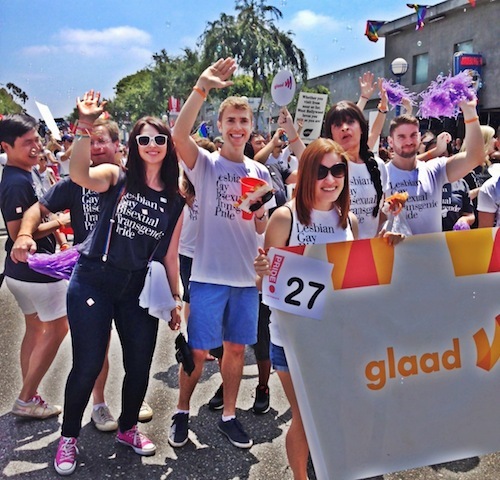For years I have heard people express their dissatisfaction with the LGBT community's propensity for over-the-top parades and flamboyant displays of pride. Admittedly, I too used to be uncomfortable with Pride parades, and even just Pride in general. My own impressions of these events came from stereotypical images shown throughout mainstream media: pictures of half-naked individuals and extravagant drag queens. I knew these parades scared certain people, even some of those trying to be more open-minded, so I thought, "Why alienate them further with loud displays of 'gayness'?" Many of us have spent the majority of our lives hiding our true identities, ashamed and worried about what the public, our family, and our friends might think. It was therefore difficult for me to understand the reasons for being so outrageous, outlandish, and, well, just plain out.
Last year I decided to assuage my apprehension (and fear) about these parades and march in the Los Angeles/West Hollywood Pride. But first, I wanted to do some research. After all, I am of a generation that did not personally experience impacting events in the gay rights movement like Harvey Milk's assassination or the AIDS crisis, and I certainly had not been educated about gay rights in school. Therefore I needed to fully comprehend why Pride parades were so important, and what I had to gain from (and ultimately give to) the experience.
It was then that I learned about the Stonewall riots.
During the 1960s, there were very few places where people could be openly gay. New York had laws prohibiting homosexuality in public, and gay establishments and private businesses were regularly raided and shut down. On June 28, 1969, at a popular gay bar in Greenwich Village, the discrimination reached a breaking point as a large group of gay men protested against police harassment. A riot ensued, and police physically assaulted the thousands of protesters.
This is a gross oversimplification of one of the most historic events in the history of the gay rights movement, one many credit as the catalyst for modern LGBT activism. What is simple, however, is understanding how crucial that day was and how it has inspired millions over the years to stand up for their rights as LGBT citizens. On the one-year anniversary of the Stonewall riots, the first Pride parades took place in Los Angeles, San Francisco, Chicago, and near the Stonewall Inn in New York. And still today they remain the most prominent displays of the fight for equality. Knowing about this event, how could I continue to refrain from participating?
So finally there I was, at my first Pride. I was surprised to find that a vast majority of the people in attendance, both as participants in the parade and as spectators along the route, were just "normal" people, dressed in "normal" clothes, like me. In the parade itself, floats mostly consisted of politicians, church groups, volunteer organizations, and straight ally groups, and not the stereotypical go-go dancers and drag queens I had predicted.
I was reminded that while the media tends to perpetuate these stereotypes, the LGBT community is just as diverse as the general population, and no single float in a parade can accurately depict an entire group. And what I learned that day was that it is not alienating flamboyance we see at events like Pride but strength, courage, and confidence exuded by people who are not afraid to be exactly who they are. It was incredibly eye-opening, and I am so thankful to have had that opportunity.
The number of global Pride parades grows exponentially each year, a clear indication of the broadening social acceptance of LGBT people and culture. I hope that more and more young people will find the courage to participate in their local marches, without fear of being judged. It can be a scary experience, but I encourage them to be brave (something with which I admittedly still struggle on a daily basis). I have the honor of marching with GLAAD this year in Los Angeles, and I can't wait to once again be surrounded by men and women who identify with my struggle and support me as I support them, with love and understanding. I hope to see you there to celebrate the progress that has already been made and fight for the positive changes yet to come.
We must continue to stand up for equality and do so loudly, but most of all proudly.
